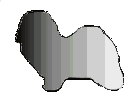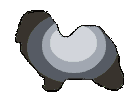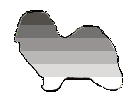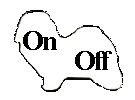
Modifying genes and variants
Individual colours are not single entities. Many different genes act together to create the colours we see. There are innumerable variations depending on the combinations. The base colour is just a start. Other genes, called modifying genes, may act upon them and changes the way those base colours are expressed. Some genes affect light colours only, others affect dark colours only and some affect both. Want to know more? There is more in depth information and explanation about genes on the genetics pages.
Photos:
You will find photos that illustrate these genes at work throughout the colour galleries. GREYING GENE: This gene is responsible for colours that progressively soften as the dog matures, like prematurely greying hair in humans, where coloured hairs are replaced with colourless or grey hairs. In the Havanese, this premature greying may start soon after birth or begin later in life. As the number of colourless or grey hairs increases and the number of coloured hairs decreases, the overall coat colour appears lighter.
GREYING GENE: This gene is responsible for colours that progressively soften as the dog matures, like prematurely greying hair in humans, where coloured hairs are replaced with colourless or grey hairs. In the Havanese, this premature greying may start soon after birth or begin later in life. As the number of colourless or grey hairs increases and the number of coloured hairs decreases, the overall coat colour appears lighter.
TICKING GENE: The ticking gene affects white portions of the coat. A parti coloured dog with this gene, in addition to his colour patches, will have matching colour flecks throughout the white coat, giving it a salt and pepper appearance. The amount of ticking can vary from a little to a lot. Dogs without this gene will have a white that stays crisp and pure. In the canine world, the term for this is "Belton". See photos in gallery 6.
 CHINCHILLA GENE:
This gene appears to act like a filter which allows or limits the production of red. This gene may be responsible for the variations of Red, Gold,
Apricot, Champagne etc. depending how little or how much red is filtered. This does not only occur on solid coloured dogs but also on the light
coat portions of patterned dogs, like the tan portions of a Black and Tan dog. This causes some confusion as many Tan Point dogs, as adults,
have no visible tan on them at all! Depending on the intensity of the gene, the points can be as dark as mahogany or as light as pale cream. There is so much variance and exceptions that don't quite fit,
that it is very likely there is an additional or different gene at play here, and that there is much more to discover.
See examples in gallery 1 and gallery 4.
CHINCHILLA GENE:
This gene appears to act like a filter which allows or limits the production of red. This gene may be responsible for the variations of Red, Gold,
Apricot, Champagne etc. depending how little or how much red is filtered. This does not only occur on solid coloured dogs but also on the light
coat portions of patterned dogs, like the tan portions of a Black and Tan dog. This causes some confusion as many Tan Point dogs, as adults,
have no visible tan on them at all! Depending on the intensity of the gene, the points can be as dark as mahogany or as light as pale cream. There is so much variance and exceptions that don't quite fit,
that it is very likely there is an additional or different gene at play here, and that there is much more to discover.
See examples in gallery 1 and gallery 4.
 SILVERING GENE: This gene appears to be similar to the chinchilla gene above in that it acts as a filter. But in this case, it filters black rather than red. A single dose of the filtering gene results in the dark silver or charcoal dog and a double dose of the gene may be responsible for the pale silver dog. This is not the same as the greying gene above. The genes act different and have a different effect. See photo examples of silvered dogs in gallery 3.
SILVERING GENE: This gene appears to be similar to the chinchilla gene above in that it acts as a filter. But in this case, it filters black rather than red. A single dose of the filtering gene results in the dark silver or charcoal dog and a double dose of the gene may be responsible for the pale silver dog. This is not the same as the greying gene above. The genes act different and have a different effect. See photo examples of silvered dogs in gallery 3.
DILUTION GENE: This gene does what it says. It dilutes base colours to watered down, weaker versions of themselves. Dilution affects all colour pigment all over the dog including nose pigment and eye colour as well as the coat colour. The dilution gene is recessive and needs two copies to be expressed. See photo examples of dilute dogs in gallery 12.
 DORSAL/VENTRAL: This may actually be two or more separate gene modifiers. The dorsal gene appears to act on the upper areas of the body (head, shoulders, back and tail) and the ventral one on the lower areas of the body (chest, belly and legs). The effects of these genes are most noticeable on Sable dogs. The dorsal areas remain darker with a heavier overlay of colour, while ventral areas lighten much more and may have no dark overlay at all remaining at maturity. You may also see this on Brindles, Silvers, and others. As adults, the dogs may be much darker on the top half of their bodies than underneath. You can see examples of this effect in assorted galleries throughout Rainbow.
DORSAL/VENTRAL: This may actually be two or more separate gene modifiers. The dorsal gene appears to act on the upper areas of the body (head, shoulders, back and tail) and the ventral one on the lower areas of the body (chest, belly and legs). The effects of these genes are most noticeable on Sable dogs. The dorsal areas remain darker with a heavier overlay of colour, while ventral areas lighten much more and may have no dark overlay at all remaining at maturity. You may also see this on Brindles, Silvers, and others. As adults, the dogs may be much darker on the top half of their bodies than underneath. You can see examples of this effect in assorted galleries throughout Rainbow.
 ON/OFF:
This is a theoretical effect to help us understand what's happening. I can't tell you more about this modifier; however, a gene such as this
does seem to exist and be at play in the Havanese. This type of gene "may" be responsible for turning other modifiers on and off,
thus possibly playing a role in dogs that lighten dramatically then deepen again as they mature. There is still much which is not yet known
about colour genetics. There may be many more genes at play than are currently known or theorized about.
ON/OFF:
This is a theoretical effect to help us understand what's happening. I can't tell you more about this modifier; however, a gene such as this
does seem to exist and be at play in the Havanese. This type of gene "may" be responsible for turning other modifiers on and off,
thus possibly playing a role in dogs that lighten dramatically then deepen again as they mature. There is still much which is not yet known
about colour genetics. There may be many more genes at play than are currently known or theorized about.
 PLUS/MINUS: Here's another that may or may not be real but appears to exist in some form.
Similar to On/Off above, such a gene as Plus/Minus seems to exist in the Havanese.
A gene such as this may act on other genes to either intensify and enhance expression, or weaken and mute it, and may be responsible for
many variations.
There is still much which is not yet known about colour genetics. There may be many more genes at play than are currently known or theorized about.
Genetics in all species is an evolving field, there is always more to be discovered and to be learned.
PLUS/MINUS: Here's another that may or may not be real but appears to exist in some form.
Similar to On/Off above, such a gene as Plus/Minus seems to exist in the Havanese.
A gene such as this may act on other genes to either intensify and enhance expression, or weaken and mute it, and may be responsible for
many variations.
There is still much which is not yet known about colour genetics. There may be many more genes at play than are currently known or theorized about.
Genetics in all species is an evolving field, there is always more to be discovered and to be learned.